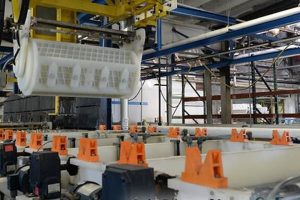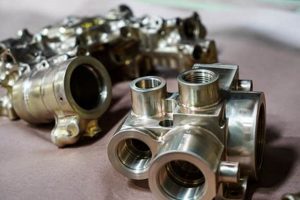A surface treatment process that imparts a lustrous, deep-blue finish, this technique enhances the aesthetic appeal and durability of metallic components. It involves specific chemical processes, often including electroplating or vapor deposition, to create a coating reminiscent of the gemstone. An example would be applying this process to watch casings or high-end automotive trim.
This finishing method is valued for its ability to provide not only an eye-catching aesthetic but also enhanced resistance to wear, corrosion, and scratches. Historically, achieving such finishes required complex and often environmentally hazardous processes. Modern advancements have focused on more sustainable and efficient techniques, increasing its appeal for various industries seeking both performance and visual appeal.
The subsequent sections will delve into the specific methods used to achieve this distinct finish, the various materials suitable for the process, and the quality control measures implemented to ensure consistent results. Furthermore, applications across diverse sectors, from aerospace to consumer electronics, will be explored, highlighting the versatility of this approach.
Tips for Achieving Optimal Results
The following recommendations are crucial for obtaining high-quality and consistent results in the application of this surface treatment. Careful adherence to these guidelines can significantly improve the final product’s appearance, durability, and overall performance.
Tip 1: Material Preparation is Paramount: Thoroughly clean and degrease the substrate material prior to treatment. Any contaminants, such as oils or oxides, can impede proper adhesion and result in an uneven finish. For example, ultrasonic cleaning is often employed for intricate parts.
Tip 2: Control Bath Chemistry Precisely: Maintaining the correct chemical composition and concentration within the plating or coating bath is critical. Regular monitoring and adjustments, based on analytical data, ensure consistent color and deposition rates. Failure to do so may yield a finish that deviates from the desired hue.
Tip 3: Optimize Current Density: Adjust the current density according to the specific alloy and bath chemistry being used. Too high a current density can lead to burning or uneven plating, while too low a density may result in a dull or thin finish. Careful experimentation is often required to determine the ideal settings.
Tip 4: Maintain Consistent Temperature: Strict temperature control is essential throughout the entire process. Fluctuations in temperature can affect the deposition rate, stress within the coating, and ultimately, the color uniformity. Thermostatic controls and regular monitoring are vital.
Tip 5: Implement Agitation or Circulation: Adequate agitation or circulation within the bath helps to maintain a uniform concentration of the plating solution at the substrate’s surface. This minimizes concentration polarization and ensures a more even deposition of the coating. Air agitation or mechanical stirring are common methods.
Tip 6: Post-Treatment Procedures are Crucial: Rinsing, passivation, and sealing processes are necessary after the coating has been applied. These steps remove residual chemicals, enhance corrosion resistance, and improve the overall durability of the finish. Insufficient post-treatment can significantly shorten the lifespan of the coating.
Tip 7: Regular Equipment Maintenance: Plating tanks, rectifiers, and other equipment must be regularly inspected and maintained to avoid inconsistent results. Faulty equipment can lead to variations in coating thickness, color, and adhesion.
By adhering to these recommendations, manufacturers can consistently achieve a high-quality, durable, and aesthetically pleasing finish. This meticulous approach is crucial for maximizing the value and performance of components utilizing this advanced surface treatment.
The following sections will build upon these foundational tips by examining specific applications and case studies, further illustrating the importance of careful process control and best practices.
1. Aesthetics
The defining characteristic of this surface treatment is its distinctive, deep-blue finish, directly influencing product aesthetics. The color evokes a sense of luxury and sophistication, making it a preferred choice for applications where visual appeal is paramount. The success of this technique hinges on its ability to consistently replicate the desired hue, which can significantly impact consumer perception and market value. For instance, high-end watch manufacturers frequently employ this finish to enhance the perceived value and elegance of their timepieces. Deviations from the target color can render the product unacceptable, highlighting the critical link between the finishing process and aesthetic outcomes.
Beyond color, the uniformity and reflectivity of the finished surface also contribute significantly to the overall aesthetic. An uneven or dull finish detracts from the intended visual impact, reducing the product’s attractiveness. Therefore, precise control over the deposition process, including factors like current density and bath chemistry, is essential to achieve a flawless aesthetic. Examples of this rigorous control can be found in the automotive industry, where consistent color matching and a high-gloss finish are crucial for maintaining brand identity and meeting consumer expectations. A subtle variation in color or surface texture can drastically alter the perceived quality of the vehicle’s trim.
In summary, aesthetics is not merely a superficial attribute but an integral component of this surface treatment, directly influencing consumer perception and product value. Achieving the desired aesthetic requires a meticulous and controlled process, emphasizing the importance of material preparation, bath chemistry management, and post-treatment procedures. While other finishing methods prioritize functionality, this technique underscores the significance of visual appeal in driving consumer preference and market success. Understanding the interplay between process variables and aesthetic outcomes is paramount for manufacturers seeking to leverage this unique finish.
2. Corrosion resistance
Corrosion resistance is a critical performance characteristic for any metal finishing process. This is particularly relevant when considering the longevity and reliability of components subjected to potentially corrosive environments.
- Noble Metal Barrier
The application of this surface treatment often involves depositing a thin layer of a relatively noble metal or alloy. This layer acts as a physical barrier, preventing corrosive agents from reaching the underlying substrate material. For example, in marine environments, this barrier can significantly reduce the rate of oxidation and degradation of steel components.
- Passivation Layer Formation
Certain chemical processes employed in this type of finishing promote the formation of a passive oxide layer on the surface. This layer is self-healing to a degree, meaning that it can reform if scratched or damaged, providing continuous protection against corrosion. Aluminum alloys, for example, benefit significantly from this passivation effect.
- Galvanic Corrosion Mitigation
When dissimilar metals are in contact in a corrosive environment, galvanic corrosion can occur. A carefully chosen finishing process can minimize this effect by either isolating the dissimilar metals or by creating a surface layer that is less prone to acting as an anode in the galvanic couple. This is crucial in applications involving connections between different metal types.
- Enhanced Chemical Resistance
The specific chemical composition of the deposited layer can be tailored to provide enhanced resistance to specific corrosive agents. For instance, a finishing process containing chromium may offer increased protection against acidic environments, while nickel-containing coatings may be more resistant to alkaline solutions. This targeted resistance extends the lifespan of the treated components in specific applications.
In summary, the improved corrosion resistance afforded by this process not only extends the service life of treated components but also enhances their reliability and performance in demanding operating conditions. By carefully selecting the appropriate finishing process and materials, engineers can mitigate the risks associated with corrosion and ensure the long-term integrity of metallic structures.
3. Durability enhancement
Durability enhancement, a primary attribute conferred by this surface treatment, stems from several key mechanisms inherent in the process. The applied coating acts as a protective barrier, mitigating the effects of wear, abrasion, and impact on the underlying substrate. The hardness of the deposited material, often exceeding that of the base metal, provides increased resistance to surface damage. For instance, in applications involving frequent handling, such as smartphone casings or watch components, the treatment significantly reduces the likelihood of scratches and blemishes. This contributes directly to the longevity and aesthetic appeal of the finished product.
The effectiveness of the treatment in enhancing durability is also tied to the adhesion properties of the coating. A strong metallurgical bond between the coating and the substrate prevents delamination or peeling, even under stress or thermal cycling. This is particularly important in automotive applications, where components are subjected to extreme temperature variations and mechanical vibrations. The treatment’s ability to maintain its integrity under these conditions ensures long-term protection and performance. The enhanced surface hardness also reduces the coefficient of friction, which minimizes wear and tear on moving parts, contributing to overall system efficiency and reliability. The aerospace industry utilizes this to improve the lifespan of critical components in harsh environments, due to the treatment preventing friction that leads to wear and tear.
In summary, durability enhancement, provided by this finishing approach, is a multifaceted benefit derived from the barrier protection, hardness, and adhesion characteristics of the applied coating. The ability to withstand wear, abrasion, and impact translates directly into increased product lifespan, reduced maintenance costs, and improved overall performance. The critical challenge lies in ensuring consistent coating quality and adhesion through precise process control and rigorous testing. As demand for long-lasting and visually appealing products continues to rise, the understanding and optimization of the durability enhancement aspects of this surface treatment become increasingly important.
4. Material compatibility
Material compatibility stands as a cornerstone in the successful application of surface treatments. Specifically, its relationship with finishing dictates the final quality, durability, and aesthetic appeal of the treated component. The selection of base metal and coating material must be carefully considered to ensure proper adhesion, prevent galvanic corrosion, and achieve the desired functional properties. Incompatibility between materials can lead to premature coating failure, compromised corrosion resistance, and an unacceptable visual outcome. For instance, applying an finish to a poorly prepared or reactive base metal can result in blistering, cracking, or discoloration of the coating. Therefore, a thorough understanding of metallurgical properties, chemical reactivity, and thermal expansion coefficients is paramount before undertaking the finishing process.
Practical applications vividly illustrate the importance of material compatibility. Consider the use of aluminum alloys in aerospace components. While aluminum offers excellent strength-to-weight ratio, it is susceptible to corrosion in certain environments. Applying finish to these components requires careful selection of coating materials that not only provide corrosion protection but also exhibit compatible thermal expansion characteristics to prevent cracking during flight operations. Another example lies in the electronics industry, where copper alloys are often used for electrical connectors. In these applications, finishes such as nickel are applied to improve wear resistance and conductivity. However, improper selection of coating thickness or inadequate surface preparation can lead to galvanic corrosion between the copper and nickel layers, resulting in compromised electrical performance. The key takeaway is that material compatibility is not merely a theoretical consideration but a critical factor impacting the long-term performance and reliability of finished products.
In conclusion, material compatibility is not a separate consideration but an integral component of the finishing process. It requires a comprehensive understanding of material properties, chemical interactions, and application-specific requirements. Challenges arise in selecting appropriate material combinations and addressing potential compatibility issues through surface preparation, barrier layers, or process modifications. Ignoring this critical aspect can lead to significant consequences, including premature product failure, increased maintenance costs, and compromised performance. Thus, a proactive and informed approach to material selection and process optimization is essential for achieving the desired outcomes.
5. Process control
The attainment of desired aesthetic and functional properties in this context hinges on meticulous process control. Deviations from established parameters invariably lead to inconsistent results, impacting the coating’s color, adhesion, and durability. Effective process control encompasses monitoring and adjusting key variables throughout the finishing procedure.
- Bath Chemistry Management
Maintaining precise chemical composition and concentration within the plating bath is paramount. Regular analysis and adjustments, based on analytical data, are necessary to ensure consistent color and deposition rates. Imbalances in bath chemistry can yield a finish that deviates from the desired hue or exhibit reduced corrosion resistance. For instance, monitoring the concentration of metal ions and complexing agents is crucial for electroplating.
- Temperature Regulation
Precise temperature control is essential throughout the entire process. Fluctuations in temperature affect the deposition rate, stress within the coating, and ultimately, the color uniformity. Thermostatic controls and continuous monitoring are vital to maintaining a stable thermal environment. Failure to control temperature can result in uneven deposition and compromised coating integrity.
- Current Density Optimization
Adjusting the current density according to the specific alloy and bath chemistry being used is critical for uniform coating. Too high a current density can lead to burning or uneven plating, while too low a density may result in a dull or thin finish. Careful experimentation is often required to determine the ideal settings. Improper current density can lead to localized defects and reduced coating performance.
- Agitation and Circulation
Adequate agitation or circulation within the plating bath helps to maintain a uniform concentration of the plating solution at the substrate’s surface. This minimizes concentration polarization and ensures a more even deposition of the coating. Air agitation or mechanical stirring are common methods. Insufficient agitation can result in variations in coating thickness and color across the component surface.
These facets of process control are not isolated entities but rather interconnected variables that must be managed holistically to achieve a consistent and high-quality finish. Implementing robust monitoring systems and adhering to established standard operating procedures are crucial for maintaining process stability and minimizing deviations. Continuous improvement efforts focused on optimizing process parameters can further enhance the aesthetic appeal and functional performance of components treated with this finishing technique. Success requires understanding and addressing various parameters through strict control.
6. Coating thickness
The dimension of the applied layer is a critical determinant of performance and longevity in surface treatment. The thickness directly influences the visual appearance, corrosion resistance, and wear characteristics of the finished product.
- Aesthetic Impact
The hue and saturation depend on coating thickness. Insufficient dimensions can result in a washed-out or inconsistent color, failing to achieve the desired visual effect. Excessive thickness can lead to cracking or peeling, compromising both aesthetics and durability. A precise thickness is, therefore, essential for achieving the intended aesthetic qualities.
- Corrosion Protection
Corrosion resistance improves with increased coating dimensions. The deposited layer acts as a barrier, preventing corrosive agents from reaching the underlying substrate. However, there are diminishing returns. Beyond a certain point, increasing the thickness provides minimal additional protection while adding to material costs and potentially increasing stress within the coating. Balancing corrosion resistance with other factors is, therefore, important.
- Wear Resistance
The ability to withstand abrasion and wear is dependent on coating thickness. A thicker layer provides a greater buffer against surface damage, extending the lifespan of the component. However, thick and brittle coatings are prone to chipping or cracking, reducing wear resistance. The selected thickness must be optimized based on the expected wear conditions and the mechanical properties of the coating material.
- Stress Management
Internal stress within the coating increases with the thickness. High internal stress can lead to coating failure, particularly under thermal cycling or mechanical loading. Managing stress through process control and material selection is essential for achieving a durable and reliable finish. The thickness should be carefully controlled to minimize stress while providing adequate protection and aesthetic appeal.
Coating thickness is a multifaceted parameter, requiring careful optimization to achieve the desired balance of aesthetic appeal, corrosion protection, and wear resistance. Effective process control and material selection are crucial for achieving consistent and reliable results. The interplay between coating thickness and these other factors must be carefully considered when specifying process requirements.
7. Application versatility
The adaptability of this process to a broad spectrum of materials, component sizes, and performance requirements is a defining characteristic. Its usefulness stems from the capacity to tailor process parameters to achieve distinct outcomes across various industries. This versatility is instrumental in expanding the reach of this finish beyond purely decorative applications, integrating it into sectors where functionality and durability are paramount.
Examples of application versatility are abundant. In the automotive sector, it enhances both interior and exterior components, improving the visual appeal and resistance to wear of trim, badging, and control surfaces. The electronics industry employs it to create aesthetically pleasing and durable casings for mobile phones, laptops, and other devices. Aerospace engineers utilize this approach to enhance the corrosion resistance of specialized fasteners and fittings. Medical device manufacturers can apply it to surgical instruments, improving scratch resistance and ease of sterilization. This wide array of applications demonstrates its capacity to meet diverse needs across technologically advanced sectors.
Therefore, application versatility contributes to its growing adoption. Challenges associated with optimizing process parameters for each application necessitate specialized expertise and rigorous quality control procedures. This understanding underscores its status as a sophisticated and valuable surface treatment option.
Frequently Asked Questions about Sapphire Metal Finishing
The following addresses common inquiries concerning this surface treatment, aiming to clarify its capabilities, limitations, and best practices.
Question 1: What is the typical thickness range for a sapphire-colored finish and how does this impact its performance?
The typical thickness ranges from 2 to 5 micrometers. This range is a trade-off between achieving the desired color saturation and maintaining adequate adhesion and flexibility. Thicker coatings may exhibit increased wear resistance but are more prone to cracking or peeling.
Question 2: What base metals are most suitable for this surface treatment?
Stainless steel, aluminum alloys, and titanium are generally well-suited due to their inherent corrosion resistance and ability to form strong metallurgical bonds with the applied coating. Compatibility testing is crucial to ensure optimal adhesion and prevent galvanic corrosion.
Question 3: How does the hardness of the coating compare to that of common base metals, and what implications does this have for scratch resistance?
The coating hardness typically exceeds that of many common base metals, such as aluminum and mild steel. This increased hardness enhances scratch resistance, providing a more durable and aesthetically pleasing surface. However, the overall scratch resistance is also influenced by the coating’s thickness and adhesion to the substrate.
Question 4: What are the primary factors that influence the consistency and uniformity of color achieved with this technique?
Bath chemistry management, temperature control, and current density optimization are the primary factors. Precise monitoring and adjustment of these parameters are essential to ensure consistent color development and uniform coating thickness across the component surface.
Question 5: What post-treatment processes are typically employed to enhance the corrosion resistance and durability of this finish?
Passivation, sealing, and application of clear coats are common post-treatment processes. Passivation enhances the formation of a protective oxide layer, sealing reduces porosity and prevents the ingress of corrosive agents, and clear coats provide an additional barrier against environmental factors.
Question 6: Are there any specific environmental regulations or safety precautions that must be observed when implementing this finishing process?
Depending on the specific chemicals and processes employed, adherence to environmental regulations regarding waste disposal and air emissions is critical. Appropriate personal protective equipment, such as gloves, respirators, and eye protection, must be worn to minimize exposure to hazardous materials.
Understanding the nuances of this surface treatment requires careful consideration of these factors. Proper implementation ensures a visually appealing and functionally superior product.
The subsequent section will explore case studies showcasing successful applications of this technology, highlighting its benefits across diverse sectors.
Conclusion
This exploration has detailed the intricacies of achieving a finish reminiscent of sapphire on metallic surfaces. Attention was given to material compatibility, precise process control, and the critical role of coating thickness. The attributes of enhanced durability, corrosion resistance, and aesthetic appeal are interwoven with the operational parameters governing its implementation. The adaptability of this approach allows its application across diverse industries, from automotive to aerospace, highlighting its broad appeal.
Moving forward, continued research into sustainable and efficient methods of surface treatment remains essential. Further investigation into novel materials and optimized application techniques promises to expand its performance envelope and applicability. The continued refinement of these processes secures its relevance in the pursuit of high-performance and visually striking components.







